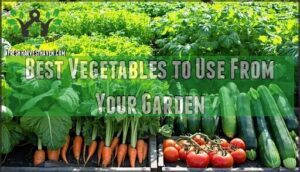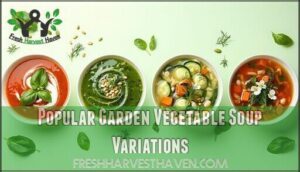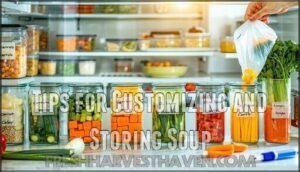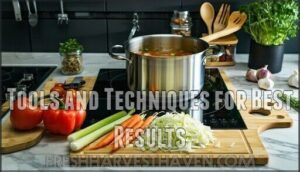This site is supported by our readers. We may earn a commission, at no cost to you, if you purchase through links.
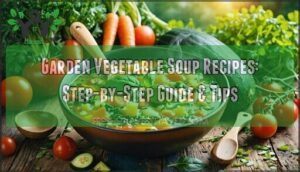 Recipes for garden vegetable soup start with simple, hearty ingredients—think carrots, celery, onions, and whatever is ripe from your garden.
Recipes for garden vegetable soup start with simple, hearty ingredients—think carrots, celery, onions, and whatever is ripe from your garden.
Toss in tomatoes and zucchini for color, and let greens like kale hold their shape and soak up broth. Use fresh basil and a pinch of thyme to bring a little sunshine to each spoonful.
Go with veggie broth for pure taste, or add richness with chicken stock. A little olive oil, a gentle simmer, and time are your best friends.
Each bowl is a canvas for your creativity, with even more tasty tricks just ahead in this guide.
Table Of Contents
Key Takeaways
- Building a garden vegetable soup starts with layering classic aromatics, seasonal veggies, and the right broth for rich, balanced flavor. – Sautéing, simmering, and adding herbs at the right times bring out the brightest tastes and best textures in your soup. – Simple ingredient swaps and pantry add-ins create endless variations, let you tailor the soup to any diet, and make leftovers easy to reinvent. – Roasting, careful prep, and smart kitchen tools boost flavor and save time, helping you turn humble garden produce into cozy, nourishing meals.
Essential Ingredients for Garden Vegetable Soup
Making great garden vegetable soup starts with choosing the right ingredients. Here’s what you need to build a flavorful and nourishing bowl from scratch.
Best Vegetables to Use From Your Garden
When you’re thinking about whipping up a batch of garden vegetable soup, reach for veggies that can handle some heat and still pack plenty of flavor and nutrition.
Fresh, in-season picks will make your home-cooked soup even more nourishing.
- Carrots and celery create a classic base for any garden soup recipe
- Tomatoes and zucchini break down beautifully while adding vibrant color
- Hardy greens like kale maintain texture and boost nutrition
Heirloom varieties often provide deeper flavor than standard types.
Herbs and Seasonings for Maximum Flavor
Fresh vegetables need the right herbs and seasonings to release their full potential in your soup. Understanding herb pairings and seasoning timing helps you layer flavor from start to finish in any soup recipe.
| Herb/Spice | Fresh vs. Dried | When to Add |
|---|---|---|
| Basil | Fresh (end) | Last 5 minutes |
| Thyme | Dried works well | Early simmering |
| Bay leaves | Dried preferred | Start of cooking |
| Parsley | Fresh (garnish) | Before serving |
| Garlic powder | Dried spice blend | With sautéed base |
That way, your soups will taste their absolute best every time you cook at home.
Broth and Liquid Options
Your soup’s foundation starts with the liquid you choose, and that choice shapes everything from body to depth of flavor. Here are your stock options:
- Vegetable broth delivers pure plant-based flavor
- Chicken stock adds richness without overpowering vegetables
- Water plus marinara creates Italian-style depth
- Half broth, half water balances flavor and soup thickness
- Bone broth boosts nutrition and body
Aim for about 4 cups of liquid for every pound of veggies you’re using—that’s the sweet spot for a flavorful, balanced soup.
Pantry Staples to Enhance Your Soup
Once you’ve chosen your liquid base, a few simple pantry staples can take your soup from good to unforgettable. These items add depth and character without much effort.
Category Examples
Keep these staples stocked for Instant Pot dinners and last-minute soup recipes that satisfy every time.
Step-by-Step Guide to Making Vegetable Soup
Making garden vegetable soup is easier than you think when you follow a clear process. Here’s how to turn fresh produce into a flavorful homemade soup from start to finish.
Prepping and Chopping Fresh Produce
Proper prep work turns a pile of raw vegetables into the foundation of a delicious soup. Start by washing all your produce under cool running water to remove dirt and debris. Peel carrots and potatoes if desired, then chop everything into uniform pieces so they cook evenly. This simple step helps home cooks create meal ideas that taste great every time.
Key prep tips for success:
- Cut harder vegetables like carrots into smaller pieces than softer ones like zucchini
- Keep your knife sharp for clean cuts and better food safety
- Strip fresh herb leaves from stems just before adding to preserve their flavor
Sautéing and Building Flavor Layers
When you heat oil in your pot and add aromatic vegetables first, you’re creating a flavor foundation that transforms simple ingredients into something extraordinary.
Home cooks should sauté onions and garlic until golden to develop rich aromas. This browning technique releases natural sugars and deepens the taste of your recipe.
Add spices early so they bloom in the oil, creating layers of flavor that make any chicken or vegetable soup unforgettable.
Simmering and Cooking Times
After you’ve built that aromatic base, the gentle simmer becomes your soup’s secret weapon—it’s where raw vegetables transform into tender bites and flavors marry into one cohesive bowl. Heat control matters. Keep these cooking techniques in mind for weeknight meals:
- Simmer at low heat for 25–35 minutes to soften vegetables without losing nutrients.
- Check firmness at 20 minutes—your recipe needs tender but not mushy texture.
- Allow natural reduction to intensify flavor concentration in your dinner recipes.
It’s the kind of trick that makes every meal taste a little more homemade.
Finishing Touches for Perfect Texture
The final minutes before serving are where you turn good soup into great soup—a drizzle of acid, a handful of fresh herbs, or a swirl of cream can wake up every flavor you’ve worked so hard to build.
Here’s your texture refinement and flavor balancing guide:
| Finishing Touch | Purpose |
|---|---|
| Fresh lemon juice or vinegar | Brightens flavors |
| Heavy cream or coconut milk | Creates creamy additions |
| Fresh parsley or basil | Adds freshness |
Taste and make seasoning adjustments before serving your weeknight dinner. These quick and easy recipes shine with proper soup thickening and cooking techniques.
Popular Garden Vegetable Soup Variations
Once you’ve mastered the basics, you can explore different styles that suit your taste and mood.
Here are four popular variations that bring fresh flavors and textures to your garden vegetable soup.
Classic Homestyle Vegetable Soup
Nothing beats a bowl of classic homestyle vegetable soup when you want comfort food that nourishes your body and warms your soul. This recipe builds flavor through simple ingredient choices and smart kitchen hacks that make weeknight dinner planning easier:
- Start with a rich chicken or vegetable broth for soup nutrition
- Layer fresh carrots, celery, tomatoes, and green beans for natural flavor boosting
- Season with bay leaves and thyme for that family meal warmth
It’s a go-to for quick weeknight dinners, and a super easy way to sneak more veggies into everyday meals.
Hearty Bean and Vegetable Soup
Adding beans to your vegetable soup transforms it from a light side dish into a protein-packed meal that keeps you full for hours.
Try white beans with kale for hearty stews or black beans with corn for weeknight meal simplicity.
This bean nutrition boost pairs well with chicken broth and garden tomatoes.
You can blend soft beans for flavor enrichment or keep them whole for texture in family meals and dinner recipes.
Creamy Garden Vegetable Soup
A creamy version wraps garden vegetables in velvety comfort without weighing you down with heavy cream. Try blending potato or cauliflower for creamy textures that mimic dishes like Tuscan White Bean Soup.
You can add coconut milk as soup creamers for richness or puree half your vegetables to keep garden freshness intact. These vegetable purees work as natural flavor enhancers for satisfying bowls.
International-Inspired Vegetable Soups
Beyond cream-based options, you can explore international recipes that bring bold flavor profiles from around the world to your table. Italian minestrone echoes Tuscan White Bean Soup with beans and vegetable broth, while Japanese kenchin-jiru uses tofu and root vegetables.
These global soup trends reflect rising interest in international cuisine and soup nutrition that spans cultures. The growing demand for comfort food is driven by global market trends.
Tips for Customizing and Storing Soup
Making soup fit your lifestyle comes down to tweaking recipes to suit your taste and keeping everything as fresh as possible.
Here’s how to customize ingredients, freeze batches, store leftovers properly, and give your soup a second life in new dishes.
Ingredient Swaps for Dietary Needs
You can make garden vegetable soup work for almost any diet with a few smart swaps. For gluten-free recipes, use chickpeas instead of pasta to add 7 grams of protein per half cup. Dairy alternatives like pureed white beans replace cream and boost fiber without saturated fat.
Vegan options include tofu for plant proteins or cashews for creaminess. Sodium reduction is simple—choose low-sodium broth and rinse canned beans to cut sodium by 40 percent.
To create a hearty meal, consider using vegetable stock as a base for added flavor and nutrition.
Batch Cooking and Freezing Methods
Once you’ve adjusted your soup to fit your diet, making big batches and freezing them saves time all week long. Batch cooking your garden vegetable soup means you can prepare four to six quarts in one session.
Cool soup completely before freezing to guarantee freezer safety. Pour portions into airtight containers, leaving one inch of space for expansion. Label each with the date and recipe name for easy meal prep on busy weeknights.
Storing Leftovers for Freshness
Your leftover soup stays fresh for three to four days in the fridge when stored properly. For best food preservation, cool it quickly and use airtight glass or BPA-free plastic containers—these are perfect for safeguarding both flavor and freshness.
Keeping your soup fresh really comes down to smart refrigeration and picking the right containers. These simple habits will save your weeknight dinners and favorite recipes from going to waste.
Creative Uses for Soup Leftovers
Turning that extra soup into something new is easier than you might think. For quick twists, try these ideas:
- Blend into a base for soup-based sauces or dips.
- Simmer down for a rich soup-based stock for other easy recipes.
- Whip chilled soup into a smoothie, or use as a filling for savory pastries.
Food preservation becomes downright fun!
Tools and Techniques for Best Results
To get the most flavor and ease from your soup, having the right tools and a few handy tricks makes all the difference.
Here’s what you’ll want to know to set yourself up for the best results.
Must-Have Kitchen Tools for Soup Making
Ever notice how the right tool in your hand can turn chopping veggies into a total breeze? Stockpot material matters—go for heavy-bottomed for even heat. A sharp vegetable peeler means less waste.
Immersion blenders, the right ladle size, and a sturdy food mill make recipes simple. Home cook community favorites? These tools, plus good cooking tips, never fail.
Knife Skills for Efficient Prep
Chopping like a pro isn’t just about speed—it’s about turning a pile of fresh veggies into bite-sized smiles, safely and with ease. Knife safety comes first—curl your fingers and keep your blade sharp.
Practice dicing techniques for hearty recipes, and master mincing herbs for salads and appetizers.
Different vegetable cuts add charm to your food—use these cooking tips often.
Roasting Vegetables for Deeper Flavor
Roasting vegetables is like turning up the volume on their natural sweetness and giving your soup a warm, golden glow.
- Use high roasting temperatures (400°F+) for those caramelization secrets. – Toss veggies with herbs for an aromatic, savory herb infusion. – Mix textures—root vegetables with zucchini—for flavor combinations that turn any easy recipe into a cozy food appetizer or casserole.
Expert Tips From Home Cooks
Isn’t it something how a little Aromatic Sautéing can transform even easy recipes into family favorites? Many home cooks swear by Layered Seasoning and tasting as you go—those small moments build Peak Texture and flavor.
Prep ahead and let your soup rest, encouraging Flavor Melding. Small Cooking Tips from kitchens like yours help you truly avoid mistakes and master new recipes.
Frequently Asked Questions (FAQs)
Can I add pasta or grains to vegetable soup?
Although you might hesitate, tossing pasta or grains into vegetable soup adds heartiness and options for easy dinner recipes.
Choose sturdy pasta types or hearty grain options, mind cooking times, and enjoy delightful texture impact and flavor pairings.
How do I make vegetable soup kid-friendly?
Often, kids warm up to vegetable soup when you use Fun Shapes for pasta, blend Hidden Vegetables for a smooth texture, or highlight Sweet Additions like corn.
Top with Creative Garnishes or try favorite Family Recipes for easy wins!
What vegetable soup toppings add crunch or flavor?
Brighten any bowl with Herb Croutons or crunchy Cheese Crisps.
For lively flavor, scatter on Seed Mixes, swirl in Spicy Oils or Yogurt Swirls.
These easy recipes turn soup into a satisfying snack or appetizer.
Is vegetable soup safe for canning at home?
Pressure canning is a must for homemade vegetable soup due to acidity levels. Low-acid foods like vegetables risk botulism if canned improperly.
Always follow safe recipes and home cooking guides to guarantee canning safety in your food preparation.
How can I boost protein in vegetable soup?
Need more protein in your soup? Try adding legumes like beans or lentils, tofu options, protein powders, grains for inclusion, a splash of dairy for a boost, or even chicken—easy upgrades found in many Simply Recipes.
Conclusion
Sometimes, the simplest recipes for garden vegetable soup lead to the richest flavors, proving less can indeed be more. With every bowl, you can turn humble produce and pantry favorites into something nourishing and comforting.
Use the steps, swaps, and tips here to create soups that fit your taste and lifestyle. Your garden—plus a touch of creativity—really is all you need for endless delicious possibilities. Enjoy the warmth and satisfaction every time you serve it.
- https://pmc.ncbi.nlm.nih.gov/articles/PMC6627832/
- https://www.healthyseasonalrecipes.com/garden-vegetable-soup/
- https://onlinelibrary.wiley.com/doi/pdf/10.1111/j.1745-459X.2007.00097.x
- https://www.datainsightsmarket.com/reports/vegetable-soup-379145
- https://www.consumerreports.org/health/nutrition-healthy-eating/is-soup-good-for-you-a1060553172/

